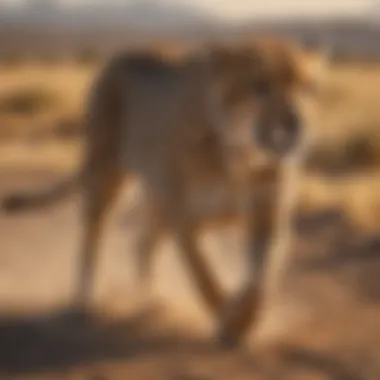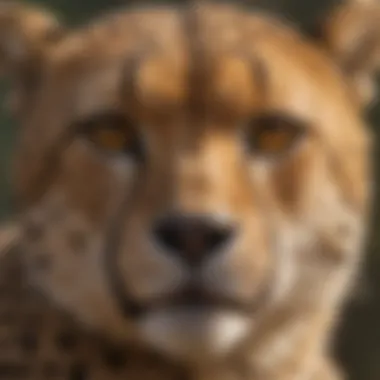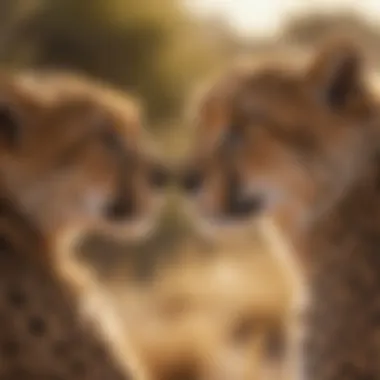Three Fascinating Aspects of Cheetahs Unveiled


Nature Topic Overview
Cheetahs are fascinating creatures that capture the attention of many. They are known for their incredible speed and unique adaptations. In this article, we will explore three main aspects of cheetahs: their unparalleled speed, their physical traits, and their interesting social structures. These insights will help young readers appreciate the complexities of nature and the importance of wildlife conservation.
Fun Facts and Trivia
Cheetahs are full of interesting facts that can engage young readers. Here are a few:
- Fastest Land Animal: Cheetahs can reach speeds up to 60 miles per hour in just a few seconds!
- Unique Black Spots: Each cheetah has a unique pattern of spots, similar to fingerprints in humans.
- Tear Marks: Their distinctive "tear marks" under their eyes help reduce glare from the sun, improving their vision while hunting.
Interactive visuals, such as diagrams showing cheetahs in motion or videos of their hunts, can enhance the learning experience for children.
Wildlife Explorations
Cheetahs belong to a unique family of large cats known as Felidae. Related species include lions, tigers, and leopards. All these animals, including cheetahs, share similar habitats, usually found in savannahs and grasslands. Understanding these related species can help children appreciate biodiversity. Here are some intriguing facts about their habitats:
- Diverse Ecosystems: Cheetahs can often be found in regions with plenty of prey, like gazelles and antelopes.
- Co-existence: They share their environment with other big cats, which can impact their hunting strategies.
Quizzes can be a fun way to engage children further, such as identifying different big cats and their characteristics.
Environmental Awareness
Cheetahs face various threats, mainly due to habitat loss and poaching. It is crucial to teach children the importance of conserving these magnificent animals. Here are a few points to discuss:
- Habitat Protection: Conserving the natural habitat prevents the extinction of cheetahs and other wildlife.
- Responsible Tourism: Encouraging responsible wildlife tourism helps support conservation efforts.
Children can help in their own way. Small actions like recycling or supporting local conservation programs can make a difference.
DIY Nature Activities
Hands-on activities can inspire a connection to nature. Here are some fun ideas:
- Cheetah Craft: Create a cheetah mask using paper plates or cardboard. Cut out eye holes and decorate with blacks and yellows to mimic cheetah spots.
- Nature Walk: Organize a nature walk to observe local wildlife, discussing the importance of habitats.
These activities encourage children to engage with nature and understand the importance of wildlife conservation.
Preamble to Cheetahs
Cheetahs are not just another big cat; they hold unique significance in the animal kingdom. Understanding them helps illuminate their role in ecosystems and their adaptation process over time. In this article, we explore various aspects of cheetahs, creating a space for educational exploration that emphasizes their remarkable abilities and the challenges they face.


Focusing on cheetahs allows readers to grasp concepts such as speed, physical adaptations, and social behaviours. This knowledge is imperative for young audiences as it nurtures their ability to appreciate wildlife and the environment.
Overview of Cheetah Species
Cheetahs belong to the family Felidae and are native to various regions across Africa and parts of Iran. They are distinguished principally by their slender bodies, long legs, and unique black tear marks on their faces. Cheetahs are typically classified into three subspecies: the African cheetah, the Asiatic cheetah, and the Northwest African cheetah.
The African cheetah is the most widely known and resides primarily in savannas, grasslands, and some forested regions. The Asiatic cheetah, while very similar, is critically endangered, with a small population mainly found in Iran.
The cheetah is also recognized for its distinct adaptations that support its hunting techniques. Unlike other big cats, cheetahs are built for speed, making them one of the fastest land mammals.
Habitat and Distribution
Cheetahs inhabit diverse ecosystems. Their primary habitats are open grasslands and savannas where they can use their speed to chase down prey.
These environments provide ample visibility, allowing cheetahs to spot prey from great distances. It is important to understand that their habitat plays a critical role in their lifestyle and survival.
Key points include:
- Geographic Range: Cheetahs are mostly found in sub-Saharan Africa and a small population in Iran.
- Adaptability: They can adjust to different types of environments, including semi-desert regions and mountains.
- Threats to Habitat: Human activity, such as deforestation and urbanization, poses severe risks to their natural habitats, consequently affecting their populations.
Cheetahs rely heavily on open land to harness their sprinting abilities, making habitat conservation vital for their survival.
As we explore further, we will uncover how these unique environments influence cheetah behaviours and adaptations.
Fact One: The Speed of Cheetahs
Cheetahs are renowned for their extraordinary speed. This capability is a defining characteristic of the species and sets them apart from other big cats. Understanding how speed influences their behavior, hunting methods, and survival strategy provides essential insights into their role in the ecosystem. Speed is not just a trait; it brings profound implications regarding their hunting techniques and prey choices, shaping their interactions with other wildlife.
Top Speed Capabilities
Cheetahs can reach impressive speeds of up to 75 miles per hour (120 kilometers per hour) in short bursts covering distances of around 1,500 feet (460 meters). This top speed makes them the fastest land animals on the planet. However, such bursts of speed can only be maintained for brief periods, typically around 20 to 30 seconds. After such exertion, they require a significant amount of time to recover. This speed is crucial when hunting, as successful chases can result in a meal, influencing their survival and the health of their populations.
"Cheetahs' top speeds allow them to outrun their prey, ensuring their essential role in their ecosystem."
Acceleration and Distance
The acceleration of a cheetah is just as remarkable as its top speed. They can accelerate from 0 to 60 miles per hour (0 to 97 kilometers per hour) in just a few seconds, which is quicker than most sports cars. This rapid acceleration is aided by their lightweight body structure and powerful leg muscles. Ideal for short distances, each sprint is optimally executed with precise focus to catch their prey. However, the strain of such exertion means they can only sustain it for short distances. It is crucial for young readers to consider that cheetahs rely on both speed and their strategic hunting techniques to locate and capture food.
Comparison with Other Animals
When comparing cheetahs to other animals, the differences in speed are quite striking. For instance, while a lion can only run about 50 miles per hour (80 kilometers per hour), the cheetah stands out as a superior sprinter. Similarly, the gray wolf, which hunts in packs, reaches maximum speeds around 40 miles per hour (64 kilometers per hour), still significantly slower than the cheetah. Other animals, like the horse, can run fast but lack the quick acceleration of a cheetah.


Fact Two: Physical Adaptations
Understanding the physical adaptations of cheetahs is essential to appreciating how well-suited they are for their role in the ecosystem. These adaptations enhance their hunting skills, enable them to survive in diverse environments, and ensure their prowess as one of nature's most renowned predators. Let's explore the numerous features that make cheetahs uniquely adapted to their lifestyle.
Unique Body Structure
The body structure of a cheetah is specifically designed for speed and agility. Unlike other big cats, cheetahs possess a lightweight body with a small, rounded head. Their spine is highly flexible, allowing them to stretch while running. This unique feature can increase their length, giving them an advantage in quick dashes during a chase. Cheetahs also have long legs, which support their rapid pace and help them cover more ground quickly.
A notable element of their physical structure is their long tail. The tail acts as a counterbalance, helping the cheetah steer while running at high speeds. This is very important, as sudden turns can be necessary while pursuing fast-moving prey like gazelles. The powerful muscles in their legs, combined with this design, enable cheetahs to achieve remarkable burst speeds.
Specialized Claws and Paws
Cheetahs have claws that are different from other felines. Unlike lions or tigers, their claws are semi-retractable. This means that the claws do not fully retract into the paw. This design gives cheetahs more grip when they run, preventing slippage at high speeds. The pads on their paws are also more textured and provide increased traction, allowing them to gain a strong foothold while sprinting.
These features offer several advantages. The ability to maintain high speeds over short distances is vital when hunting. Additionally, the grip provided by their specialized claws helps them corner effectively while chasing fast prey. These adaptations are essential skills for survival in the wild.
Vision and Sensory Abilities
Cheetahs exhibit exceptional vision, which is crucial for spotting prey from a distance. Their large eyes are positioned facing forward, emphasizing their depth perception. This adaptation allows cheetahs to estimate distances accurately when sprinting towards their target.
Moreover, cheetahs have a high concentration of retinal cells, giving them sharp eyesight, especially in daylight. This is particularly advantageous in their natural habitat where they often hunt during the day. Having good eyesight helps them locate areas where prey might be hiding.
Cheetahs have other sensory abilities that enhance their overall hunting effectiveness. Their acute hearing allows them to detect even the slightest sounds from potential prey. This awareness can prove invaluable when stalking. Together, these sensory adaptations are fundamental to a cheetah's hunting strategy.
The adaptations of the cheetah are an extraordinary example of nature's design, enabling them to thrive as fast and effective hunters.
In summary, the physical adaptations of cheetahs, including their body structure, specialized claws and paws, and powerful sensory skills, define their place in the animal kingdom. Understanding these aspects is vital to appreciate how they not only survive but also excel in their environment.
Fact Three: Social Behaviors
Social behaviors in cheetahs are intriguing and complex. Understanding how these animals interact with one another provides valuable insights into their survival and adaptation strategies. Social structures among cheetahs differ from those of other big cats, primarily due to their unique hunting and living habits. In this section, we will examine individual versus group dynamics, mother and cub relationships, and communication methods.
Individual vs. Group Dynamics
Cheetahs, unlike lions, are usually solitary creatures. However, they also form small groups called coalitions. Male cheetahs often come together to form these groups. A coalition usually consists of two to four brothers that work in harmony to hunt and protect their territory from other males and potential threats.
- Benefits of Group Living:
- Hunting effectiveness: Groups can take down larger prey.
- Increased protection: Coalitions provide security against intruders.
However, female cheetahs tend to be solitary, raising their cubs alone. They establish their territory and use it for hunting and nurturing their young. The social behavior of cheetahs varies to adapt to individual needs.
Mother and Cub Relationships


The bond between a cheetah mother and her cubs is vital for survival. A mother gives birth to three to five cubs after a gestation period of about 90 to 95 days. During the first few weeks, the cubs are helpless and rely entirely on their mother for nutrition and safety.
- Nurturing: A mother carefully keeps her cubs hidden while they are very young. She chooses dense vegetation to provide shelter.
- Teaching: As the cubs grow, the mother teaches them essential hunting skills and survival tactics. She demonstrates how to stalk and pounce, crucial techniques for their development.
This nurturing phase lasts about 18 months. The mother stops feeding the cubs when they reach around 18 to 24 months as they become independent.
Communication Methods
Cheetahs have various ways to communicate, which helps them maintain social bonds and avoid conflicts. Their communication includes vocalizations, body language, and scent markings.
- Vocal Communication: Cheetahs use different sounds such as purring, chirping, and hissing. Each sound conveys distinct messages, from calling to warning.
- Body Language: Their posture and movements often communicate feelings. For instance, crouching may indicate a defensive or fearful behavior.
- Scent Marking: Cheetahs use urine marking to establish territory. This action signals other cheetahs about their presence and boundaries.
Understanding these social behaviors offers insights into how cheetahs survive and thrive in the wild. It emphasizes the importance of social structures in their daily lives.
In summary, cheetahs exhibit distinct individual and group behaviors that are essential for their survival. Their unique mother and cub dynamics provide a nurturing environment, while their various communication methods facilitate interactions and help avoid conflicts. These elements are crucial for maintaining their populations in different habitats around the world.
Conservation Status
The conservation status of cheetahs is an essential part of understanding their plight in the wild. As populations decline, awareness of their situation becomes crucial. Cheetahs, classified as vulnerable by the International Union for Conservation of Nature, face various challenges that threaten their survival. Recognizing these threats allows us to appreciate the need for targeted conservation efforts. With a population estimate of fewer than 7,000 individuals left in the wild, the struggle to protect these magnificent animals is paramount.
Threats to Cheetah Populations
Several factors contribute to the decline of cheetah populations:
- Habitat Loss: Urbanization and agricultural expansion are the primary reasons for habitat destruction. Cheetahs need vast territories to roam and hunt. When their habitat shrinks, they become trapped in isolated areas, limiting their ability to find mates and food.
- Human-Wildlife Conflict: As humans encroach on cheetah habitats, conflicts arise. Farmers sometimes view cheetahs as threats to livestock, leading to retaliation often through lethal means. This human-wildlife conflict takes a toll on cheetah numbers and can devastate local wildlife populations, further complicating ecosystem balance.
- Poaching and Illegal Trade: Despite not being consistently targeted for their pelts unlike tigers, cheetahs are still victims of poaching. Their cubs are often taken and sold as exotic pets, and some adults fall prey to illegal hunting practices. These actions contribute to their endangered status and hinder recovery efforts.
"Understanding the threats cheetahs face helps us devise better solutions for their conservation."
Efforts for Protection and Rehabilitation
Efforts to aid cheetah conservation are both diverse and vital. There are ongoing global initiatives aimed at protecting these animals and their habitats:
- Protected Areas: Establishing wildlife reserves and national parks protects cheetah habitats. These areas allow cheetahs to live safely, hunt, and reproduce without the threat of human encroachment.
- Community Engagement: Involving local communities in conservation efforts is crucial. Programs educate residents about the ecological importance of cheetahs, emphasizing coexistence instead of conflict. These programs can include financial incentives for protecting wildlife rather than harming it, which helps change perspectives.
- Breeding Programs: Zoos and wildlife rehabilitation centers are establishing breeding programs for cheetahs to increase genetic diversity and population numbers. These programs aim to create a stable population that may someday be reintroduced into their natural habitats.
- Research and Monitoring: Researchers conduct studies to understand cheetah behaviors and habitats better. Tracking movements and population dynamics aids conservationists in creating effective strategies to bolster cheetah survival.
Cheetah conservation is an ongoing effort that requires global awareness and local action. By understanding threats and supporting protective measures, we contribute to ensuring that these remarkable creatures can continue to roam our planet.
End
In wrapping up this exploration of cheetahs, the significance of understanding their unique traits and challenges cannot be overstated. As one of the fastest land animals, cheetahs inspire awe in observers and are also crucial to the ecosystem. This article emphasizes several key elements that enhance our knowledge of these intriguing creatures.
Summarizing Key Insights
Cheetahs are often celebrated for their exceptional speed, reaching up to 75 miles per hour in short bursts. However, speed is complemented by physical innovations such as a lightweight build, specialized claws, and keen eyesight. These adaptations support their hunting prowess and survival in their natural habitats, primarily grasslands and savannas. Furthermore, the social structures of cheetahs add a layer of complexity to their behavior. Whether they are solitary or forming small groups, their interactions reveal much about their needs and instincts. Ultimately, the challenges cheetahs face, from habitat loss to human conflicts, highlight the urgent need for conservation efforts.
Encouraging Further Exploration
Understanding cheetahs opens doors to broader discussions about wildlife conservation. Children and young readers can be motivated to learn more about how various animal species adapt to their environments. Engaging with cheetah documentaries, visiting local zoos, or participating in wildlife conservation programs can foster a deeper appreciation for nature. Resources such as Wikipedia and Britannica serve as excellent starting points for anyone interested in delving deeper into the lives of cheetahs and the risks they face. By increasing awareness and sharing this knowledge with friends and family, we can all contribute to a future that protects these remarkable animals.







